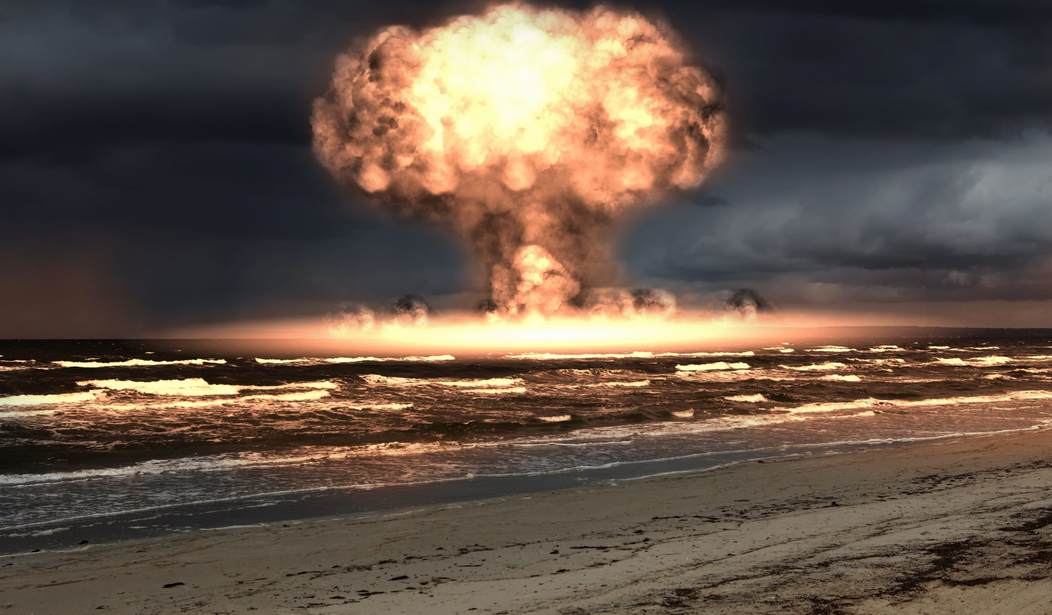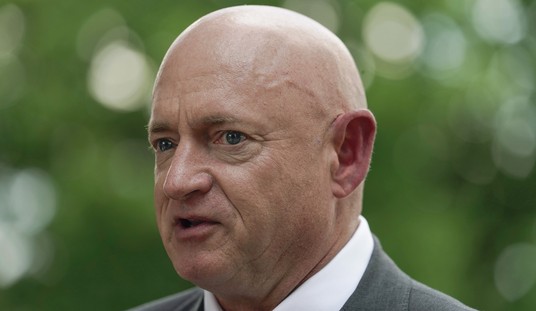On the 72nd anniversary of the atomic bomb falling on Hiroshima, Japan, it’s high time to correct the record: “the Bomb” didn’t defeat Japan in World War II, and what actually happened lends support to President Donald Trump’s approach on nuclear weapons.
In April 2016, Trump infamously said that he would not rule out using nuclear weapons. “I don’t want to rule out anything,” the then-candidate declared. “I will be the last to use nuclear weapons. It’s a horror to use nuclear weapons. … I will not be a happy trigger like some people might be. But I will never, ever rule it out.”
Perhaps ironically, the true history of what happened when the U.S. used nuclear weapons against Hiroshima and Nagasaki on August 6, 1945, and August 9, 1945, backs up the idea that nukes — while dangerous and deadly and only useful in a last resort — are not quite as powerful as commonly believed.
The story has been repeated so many times, few question it. Emperor Shōwa, better known as Hirohito, made the decision to end World War II and surrender on August 9, 1945, three days after the first atomic bomb dropped on Hiroshima and on the very day the second bomb dropped on Nagasaki. Despite the Japanese culture of honor, he accepted unconditional surrender because of the might and terror of this new nuclear weapon.
But the timing, scale, and strategy of Japan’s surrender actually does not square with this conventional reading of the end of the war. Ward Wilson, a senior fellow at the British American Security Information Council and author of Five Myths About Nuclear Weapons, explained why the conventional wisdom is wrong in a 2013 article for Foreign Policy magazine.
As Wilson explained, the first problem with the “our bomb did it!” narrative is timing: Japan’s Supreme Council for the Direction of the War (a kind of Emperor’s cabinet that effectively controlled Japan, but had never met in person before) convened on the morning of August 9, a full three days after news of the Hiroshima bombing had reached Tokyo. The bombing had killed about a third of the city’s population and destroyed about two thirds of the city itself.
Had the devastation of Hiroshima been the cataclysmic event pushing Japan to surrender, the Supreme Council would have met quickly after news first reached Tokyo. In fact, Foreign Minister Togo Shigenori went to Premier Suzuki Kantaro on August 8, explicitly asking for the Supreme Council to meet and discuss the Hiroshima bombing, but the other council members declined.
Wilson noted that the Japanese already understood, at least roughly, what nuclear weapons were — they themselves had a nuclear weapons program, and military leaders acknowledged the type of bomb that struck Hiroshima in their diaries.
If not Hiroshima, did Nagasaki force the surrender? Arguably, no. The Supreme Council met to discuss surrender early on the morning of August 9. Nagasaki was bombed around 11 a.m. News of the bombing did not reach Japan’s leaders until the early afternoon, when the Supreme Council had already been adjourned in deadlock and before Hirohito intervened to force the surrender.
So what caused the surrender? Wilson pointed to the U.S.S.R.’s declaration of war against Japan late in the evening of August 8, and its invasion of Manchukuo around midnight on August 9.
Why didn’t Hiroshima and Nagasaki — the first two uses of the atomic bomb on populated cities — force the Japanese to surrender? Wilson explained that these two bombings, horrendous as they were, might not have stood out to the Japanese people at the time (emphasis added):
In the summer of 1945, the U.S. Army Air Force carried out one of the most intense campaigns of city destruction in the history of the world. Sixty-eight cities in Japan were attacked and all of them were either partially or completely destroyed. An estimated 1.7 million people were made homeless, 300,000 were killed, and 750,000 were wounded. Sixty-six of these raids were carried out with conventional bombs, two with atomic bombs. The destruction caused by conventional attacks was huge. Night after night, all summer long, cities would go up in smoke. In the midst of this cascade of destruction, it would not be surprising if this or that individual attack failed to make much of an impression — even if it was carried out with a remarkable new type of weapon.
Wilson explained that a typical raid involved dropping 4 to 5 kilotons of bombs on a city. A kiloton is a thousand tons and is the standard measure of the explosive power of a nuclear weapon. The Hiroshima bomb measured 16.5 kilotons, and the Nagasaki bomb 20 kilotons. Ironically, the conventional bombing raids were arguably more effective, since they spread the destruction evenly.
The single most destructive attack on a city in the history of war wasn’t Hiroshima or Nagasaki, but the bombing raid on Tokyo five months before. This raid — carried out only with conventional weapons — destroyed about 16 square miles of Tokyo and killed an estimated 120,000 people, the single highest death toll of any bombing attack on a city in history.
Contrary to popular belief, Hiroshima and Nagasaki were not the most devastating attacks on Japan. Of the 68 cities bombed in the summer of 1945, Hiroshima was second in terms of civilian deaths, but it was fourth in terms of the number of square miles destroyed, and 17th in terms of percentage of city destroyed.
Wilson put himself in the minds of Japan’s leaders in July and August 1945. “On the morning of July 17, you would have been greeted by reports that during the night four cities had been attacked: Oita, Hiratsuka, Namazu, and Kuwana. Of these, Oita and Hiratsuka were more than 50 percent destroyed. Kuwana was more than 75 percent destroyed and Numazu was hit even more severely, with something like 90 percent of the city burned to the ground.”
Three days later, another story: three more cities destroyed with Fukui more than 80 percent obliterated. A week later, three more cities attacked. Two days later, six more cities attacked in one night, with Ichinomiya 75 percent destroyed. On August 2, four more cities were destroyed, and Toyama had been 99.5 percent obliterated. On August 5, four more cities were attacked.
On August 6, only one city, Hiroshima, was attacked — but reports said the damage was great and a new type of bomb was used. Chillingly, Wilson asked, “How much would this one new attack have stood out against the background of city destruction that had been going on for weeks?”
If all this destruction didn’t cause Japan to surrender, why did the U.S.S.R.’s entry into the war do the trick?
Japan’s leaders knew they were losing the war, but they wanted to negotiate a surrender, not agree to an unconditional one, which the Allies demanded. The Japanese high command wanted to avoid war crimes trials, keep their form of government, perhaps even hold on to some of the territories conquered in the war, such as Korea, Vietnam, Burma, parts of Malaysia and Indonesia, eastern China, and various Pacific islands.
They had two plans to get better surrender terms. One involved the Russians brokering a surrender between Japan and the Allies. The other involved forcing better terms through military engagement. If Japanese troops cost Americans heavy casualties when the U.S. invaded, they might force America to offer better terms.
Russia’s declaration of war and its subsequent invasion of Japan’s puppet state in northern China undercut both of Japan’s plans to achieve better terms of surrender. Japan could not effectively cause hefty casualties among U.S. troops while also fighting off Russian troops in the west, and Russia would not negotiate a better surrender if it were also at war with Japan.
The death and destruction of the atomic bombs were horrible, unspeakable even. But they were comparable to the destruction of conventional weapons, and they were not the defining factor in Japan’s surrender.
But the story of the bomb causing the surrender was a helpful narrative, for both America and Japan, as Wilson argued. If the atomic bomb was a huge step forward and caused the surrender of Japan, that underlined America’s innovation and power. Furthermore, if it were known that Japan surrendered because of the U.S.S.R., that would give the Soviets a leg up at the beginning of the Cold War.
Furthermore, the narrative of the horrors of Hiroshima and Nagasaki allowed the Japanese to play the victim in the war. It has been estimated that the Japanese military murdered between 3 and 10 million people. They killed approximately 3.9 million Chinese alone, mostly civilians. Multiple atrocities included the Nanking Massacre, the slaughter of Hui Muslims, the Manila massacre, the Sook Ching massacre, and many others.
In light of the Cold War’s end, it is important for Americans today to understand the real story behind Japan’s surrender.
The narrative of atomic bombs ending Japan’s historic resolve has clouded discussions of nuclear weapons. Nuclear weapons are seen as unpalatable, utterly different from conventional weapons, and an unspeakable evil.
To be clear, nuclear weapons are uniquely powerful. As Anthony J. Colangelo, a professor at Southern Methodist University, wrote in the Los Angeles Times, nuclear weapons have unique blast power, release dangerous radiation, make humanitarian assistance after the blast impossible, deal long-term damage to the environment, and carry out generational psychological injury. The prospect of North Korea having them is truly terrifying.
But conventional weapons are not to be underestimated. A stroll along the top of Point du Hoc in Normandy, France, will reveal the sheer power of conventional bombs — the land is pockmarked with craters five feet deep. The famous war scenes from Hacksaw Ridge (2016), Band of Brothers (2001), and Saving Private Ryan (1998) did not involve any nukes. The bombing raids carried out over London and Berlin during World War II were rightly infamous, and the worst city attack in history was Tokyo, hit by American conventional bombs a full five months before Hiroshima.
Nuclear weapons are terrifying and tragic, but they are merely one more step in devastation. War is hell, nukes or no nukes.
President Donald Trump rightly noted that nuclear weapons are a last resort, and it seems unlikely the circumstances will ever require their use. But he is also right never to rule them out, especially with North Korea testing long-range ballistic missiles. Neutralizing Kim Jong Un may require nuclear weapons, and Trump is right not to take them off the table.









Join the conversation as a VIP Member